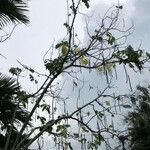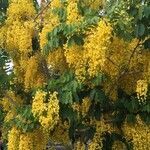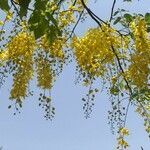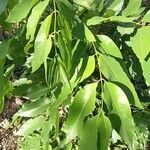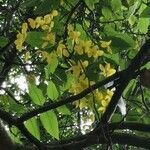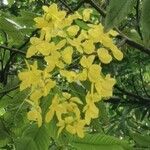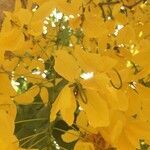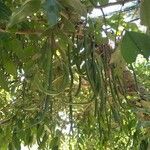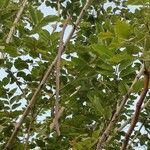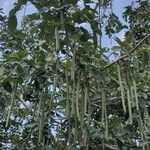| Therapeutic use
|
Abdominal pain (bark), Abortifacient agents (bark), Acne vulgaris (bark), Amenorrhea (bark), Analgesics (bark), Anthelmintics (bark), Antifungal agents (bark), Anti-infective agents (bark), Antineoplastic agents (bark), Antipyretics (bark), Antirheumatic agents (bark), Antiviral agents (bark), Astringents (bark), Blindness (bark), Burns (bark), Cardiotonic agents (bark), Cathartics (bark), Chest pain (bark), Colic (bark), Contraceptive agents (bark), Diabetes mellitus (bark), Diarrhea (bark), Diuretics (bark), Dysentery (bark), Dyspepsia (bark), Edema (bark), Emetics (bark), Facial paralysis (bark), Fever (bark), Furunculosis (bark), Gastrointestinal diseases (bark), Headache (bark), Heart diseases (bark), Herpes simplex (bark), Hypoglycemic agents (bark), Inflammation (bark), Insect bites and stings (bark), Insect repellents (bark), Insecticides (bark), Labor pain (bark), Laxatives (bark), Leprosy (bark), Liver diseases (bark), General tonic for rejuvenation (bark), Scorpion stings (bark), Skin diseases (bark), Snake bites (bark), Splenomegaly (bark), Ulcer (bark), Urination disorders (bark), Vitiligo (bark), Wounds and injuries (bark), Antinematodal agents (flower), Antipruritics (flower), Antipyretics (flower), Astringents (flower), Bronchitis (flower), Cathartics (flower), Cough (flower), Demulcents (flower), Digestive system diseases (flower), Emollients (flower), Expectorants (flower), Leprosy (flower), Mycoses (flower), Pain (flower), Skin diseases (flower), Stomach diseases (flower), Uterine contraction (flower), Vomiting (flower), Abortifacient agents (fruit), Acne vulgaris (fruit), Amenorrhea (fruit), Analgesics (fruit), Anorexia (fruit), Antifungal agents (fruit), Anti-inflammatory agents (fruit), Antineoplastic agents (fruit), Antipruritics (fruit), Antipyretics (fruit), Antirheumatic agents (fruit), Antiviral agents (fruit), Appetite stimulants (fruit), Asthenia (fruit), Asthma (fruit), Cardiovascular diseases (fruit), Cathartics (fruit), Chest pain (fruit), Colic (fruit), Common cold (fruit), Constipation (fruit), Contraceptive agents (fruit), Cough (fruit), Diabetes mellitus (fruit), Disinfectants (fruit), Diuretics (fruit), Dysentery (fruit), Dyspepsia (fruit), Earache (fruit), Eczema (fruit), Edema (fruit), Emollients (fruit), Estrogen receptor modulators (fruit), Eye diseases (fruit), Fever (fruit), Flatulence (fruit), Furunculosis (fruit), Gout (fruit), Graves ophthalmopathy (fruit), Heart diseases (fruit), Hematologic diseases (fruit), Hemorrhoids (fruit), Hepatomegaly (fruit), Hypoglycemic agents (fruit), Inflammation (fruit), Jaundice (fruit), Labor pain (fruit), Laxatives (fruit), Leprosy (fruit), Liver diseases (fruit), Menstruation-inducing agents (fruit), Pain (fruit), Pharyngitis (fruit), Pneumonia (fruit), General tonic for rejuvenation (fruit), Skin diseases (fruit), Snake bites (fruit), Stomach diseases (fruit), Tongue diseases (fruit), Tonsillitis (fruit), Urinary retention (fruit), Urination disorders (fruit), Urologic diseases (fruit), Vitiligo (fruit), Whooping cough (fruit), Washerman's itch (leaf), Abdominal pain (leaf), Acne vulgaris (leaf), Angiotensin-converting enzyme inhibitors (leaf), Antifungal agents (leaf), Anti-infective agents, local (leaf), Anti-inflammatory agents (leaf), Antimutagenic agents (leaf), Antinematodal agents (leaf), Antipruritics (leaf), Antipyretics (leaf), Antirheumatic agents (leaf), Antitoxins (leaf), Asthma (leaf), Astringents (leaf), Brain diseases (leaf), Carbuncle (leaf), Cathartics (leaf), Common cold (leaf), Constipation (leaf), Diabetes mellitus (leaf), Eczema (leaf), Edema (leaf), Emaciation (leaf), Emetics (leaf), Facial paralysis (leaf), Fever (leaf), Gout (leaf), Hemorrhoids (leaf), Herpes simplex (leaf), Hypoglycemic agents (leaf), Inflammation (leaf), Insect bites and stings (leaf), Insect repellents (leaf), Insecticides (leaf), Intestinal diseases, parasitic (leaf), Counterirritant (leaf), Jaundice (leaf), Laxatives (leaf), Leprosy (leaf), Migraine disorders (leaf), Paralysis (leaf), Prurigo (leaf), General tonic for rejuvenation (leaf), Scabies (leaf), Skin diseases (leaf), Ulcer (leaf), Wounds and injuries (leaf), Antiperiodic (leaf), Abnormal delivery (root), Analgesics (root), Antifungal agents (root), Antipyretics (root), Antirheumatic agents (root), Arthralgia (root), Arthritis (root), Astringents (root), Breast diseases (root), Cardiovascular diseases (root), Cathartics (root), Chest pain (root), Common cold (root), Constipation (root), Diabetes mellitus (root), Dysentery (root), Dyspepsia (root), Dysuria (root), Edema (root), Fever (root), Furunculosis (root), Gastrointestinal diseases (root), Heart diseases (root), Hemorrhage (root), Jaundice (root), Laxatives (root), Leishmaniasis, visceral (root), Leprosy (root), Liver diseases (root), Migraine disorders (root), Pain (root), Pyoderma (root), General tonic for rejuvenation (root), Skin diseases (root), Snake bites (root), Syphilis (root), Tuberculosis (root), Tuberculosis, lymph node (root), Ulcer (root), Vomiting (root), Wound healing (root), Wounds and injuries (root), Anthelmintics (seed), Anti-bacterial agents (seed), Antinematodal agents (seed), Antiprotozoal agents (seed), Antipyretics (seed), Antirheumatic agents (seed), Appetite stimulants (seed), Bile acids and salts (seed), Cardiotonic agents (seed), Cathartics (seed), Constipation (seed), Diabetes mellitus (seed), Digestive system diseases (seed), Diuretics (seed), Dysentery, amebic (seed), Emetics (seed), Filariasis (seed), Flatulence (seed), Gastric acid (seed), Jaundice (seed), Laxatives (seed), Leprosy (seed), Liver diseases (seed), Menorrhagia (seed), Migraine disorders (seed), Pain (seed), Pharyngitis (seed), General tonic for rejuvenation (seed), Scabies (seed), Skin diseases (seed), Toothache (seed), Urinary retention (seed), Vomiting (seed), Antifungal agents (shoot), Antinematodal agents (stem), Antineoplastic agents (stem), Jaundice (stem), Tuberculosis (stem), Aperient (unspecified), Astringent (unspecified), Burn (unspecified), Cancer (unspecified), Carbuncle (unspecified), Convulsion (unspecified), Dermatosis (unspecified), Diarrhea (unspecified), Dysuria (unspecified), Epilepsy (unspecified), Flu (unspecified), Fumitory (unspecified), Gravel (unspecified), Hematuria (unspecified), Herpes (unspecified), Laxative (unspecified), Pimple (unspecified), Purgative (unspecified), Syphilis (unspecified), Tumor(Glands) (unspecified), Vermifuge (unspecified), Constipation (unspecified), Delirium (unspecified), Wound (unspecified), Abdominal pain (unspecified), Acne vulgaris (unspecified), Analgesics (unspecified), Anthelmintics (unspecified), Anthrax (unspecified), Anticonvulsants (unspecified), Antipruritics (unspecified), Antipyretics (unspecified), Antirheumatic agents (unspecified), Antitubercular agents (unspecified), Antitussive agents (unspecified), Appetite stimulants (unspecified), Astringents (unspecified), Burns (unspecified), Cardiovascular diseases (unspecified), Cathartics (unspecified), Common cold (unspecified), Diabetes mellitus (unspecified), Digestive system diseases (unspecified), Disinfectants (unspecified), Dysentery (unspecified), Eczema (unspecified), Emetics (unspecified), Eye diseases (unspecified), Fever (unspecified), Filariasis (unspecified), Fractures, bone (unspecified), Gout (unspecified), Heart diseases (unspecified), Hematemesis (unspecified), Hoarseness (unspecified), Intestinal diseases, parasitic (unspecified), Jaundice (unspecified), Kidney calculi (unspecified), Laxatives (unspecified), Leprosy (unspecified), Liver diseases (unspecified), Lung diseases (unspecified), Malaria (unspecified), Migraine disorders (unspecified), Neoplasms (unspecified), Anti-poisoning (unspecified), Pregnancy (unspecified), Pyoderma (unspecified), General tonic for rejuvenation (unspecified), Scabies (unspecified), Scorpion stings (unspecified), Skin diseases (unspecified), Snake bites (unspecified), Stomach diseases (unspecified), Tuberculosis, lymph node (unspecified), Urination disorders (unspecified), Vitiligo (unspecified), Vomiting (unspecified), Child health (unspecified), Abscess (wood), Dysentery (wood), Heart diseases (wood), Jaundice (wood), Leprosy (wood), Syphilis (wood)
|
